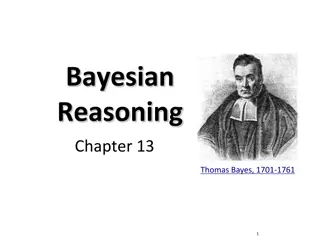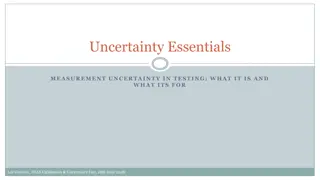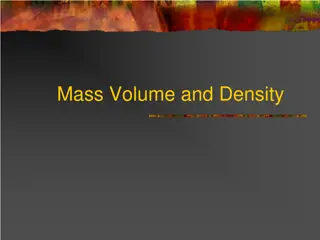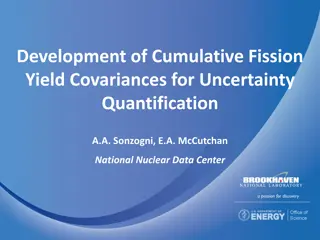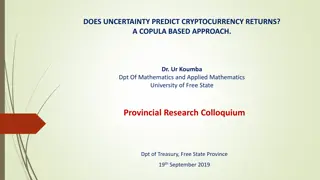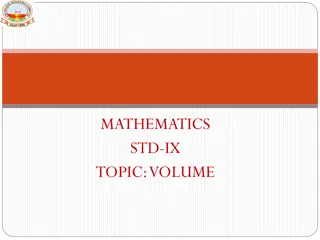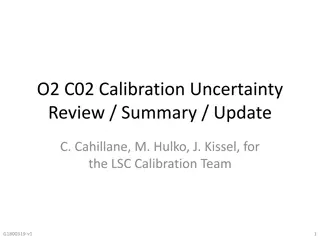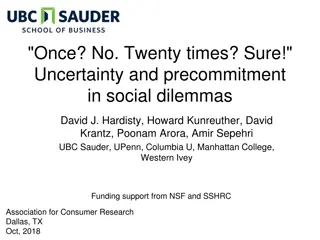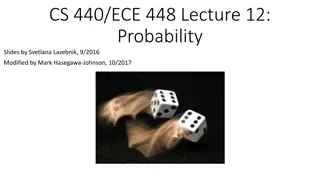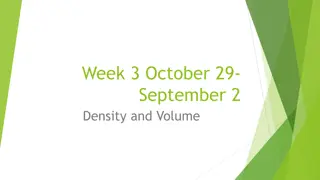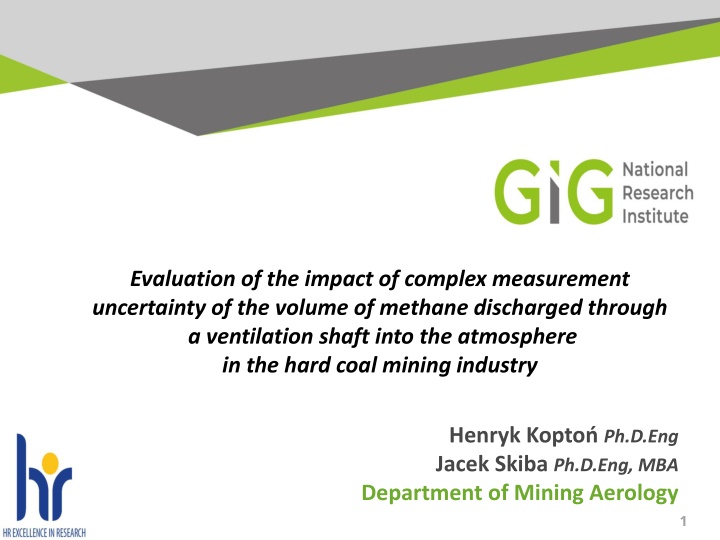
Impact of Complex Measurement Uncertainty on Methane Volume in Coal Mining
Explore the evaluation of complex measurement uncertainty on the volume of methane discharged through ventilation shafts in coal mining, assessing its impact and importance in emission management for economic and environmental reasons.
Download Presentation

Please find below an Image/Link to download the presentation.
The content on the website is provided AS IS for your information and personal use only. It may not be sold, licensed, or shared on other websites without obtaining consent from the author. If you encounter any issues during the download, it is possible that the publisher has removed the file from their server.
You are allowed to download the files provided on this website for personal or commercial use, subject to the condition that they are used lawfully. All files are the property of their respective owners.
The content on the website is provided AS IS for your information and personal use only. It may not be sold, licensed, or shared on other websites without obtaining consent from the author.
E N D
Presentation Transcript
Evaluation of the impact of complex measurement uncertainty of the volume of methane discharged through a ventilation shaft into the atmosphere in the hard coal mining industry Henryk Kopto Ph.D.Eng Jacek Skiba Ph.D.Eng, MBA Department of Mining Aerology 1
Plan of the presentation 1. Introduction 2. Methodology for measuring air flow rate and methane concentration in a ventilation shaft 3. Determination of the complex measurement uncertainty of the volume of methane discharged through a ventilation shaft 4. Evaluation of the impact of measurement uncertainty on the volume of methane emitted from a ventilation shaft to the atmosphere 5. Summary
Circulation of data on methane emissions from coal mines in Poland Coal mine Local Mining Authority Higher Mining Authority In accordance with the Act of 17 July 2009 on the greenhouse gas and other substances emission management system (i.e. Journal of Laws 2020, item 1077, as amended), the entity responsible for preparing the national greenhouse gas emission inventory for the European Union is KOBIZEKOBIZE the National Balancing and Emission Management Centre (KOBIZE) at the Institute of Environmental Protection - National Research Institute According to IPCC:2006 IPCC Guidelines for National Greenhouse Gas Inventories Draft Proposal for a Regulation of the European Parliament and of the Council on the reduction of methane emissions in the energy sector and amending Regulation (EU) 2019/942. This regulation, provides for the payment of charges for above-normal methane emissions to atmospheric air (so-called vent methane). In this situation, the accuracy of the measurement of the calculation of methane emissions is important from an economic point of view. In this publication, the measurement uncertainty in the estimation of methane emissions from a ventilation shaft is presented in a simplified manner.
Methodology for measuring exhaust shaft's air outflow and methane (VAM) concentration in it Schematic diagram for measuring methane emissions from a ventilation shaft
Determination of the complex measurement uncertainty of the volume of methane discharged through a ventilation shaft Determining the methane flow rate through a workings can be recognised as a complex measurement, so that its value is influenced by the measurement values of more than one physical quantity. The value of methane flow rate for the applied measurement method is given by the relation: ???4= 0.01????4 where: ? - air volume flow [m3/s] ???4- average concentration of methane in the measuring cross-section [ %]. The air volume flow rate Q depends on the size of the excavation cross-section F and the flow velocity v. Assuming that the excavation is made in the casing P with width a and height b, its cross-section in simplified terms can be presented: ? = 0.8?? [m2] thus, ? = 0.8??? [m3/s]
Determination of the complex measurement uncertainty of the volume of methane discharged through the ventilation shaft Based on the above relationships, the combined variance of the methane volume flux ?2???4 will be: 2 + 2 2 2 ? ???4 ???4 ? ? ? ? ? ? ? ? ? 2 ?2???4= ???4 + + where : ? ? uncertainty of measurement of air volume velocity, ? ? measurement uncertainty of excavation width, ? ? uncertainty of excavation height measurement, ? ???4 uncertainty of measurement of the average concentration of methane in the measurement section. Assuming a roughly rounded expansion factor of k=2 (its value, assuming a normal distribution of the measured quantity, for a confidence level of 95%, is equal to 1.96), the relationship for the expanded uncertainty in the measurement of methane flux can be expressed as follows: 2 2 2 2? ???4 ???4 ? ? ? ? ? ? ? ? ? ? ???4= 2???4 + +
Determination of the complex measurement uncertainty of the volume of methane discharged through the ventilation shaft Assuming in the example measurement model that: v=9.5 m/s, a=6.5 m, b=4.5 m, cCH4=0.28%, then the current flow rate of air flowing into the ventilation shaft will be 221.1 m3/s and the value of methane volume flux will be ???4= 0.62 m3/s = 37.2 m3/min. At the same time, the complex expanded measurement uncertainty of the methane flow rate through the ventilation shaft in the analyzed case will be: 2 2 2 2 0,130 9,45 0,003 6,5 0,003 4,5 0,033 0,28 =0.147 m3/s ? ???4= 1.24 + + + The relative measurement uncertainty of the methane flux flowing through the shaft will be: ? ???4 ???4 100% = ? ???4100% = 23.71% Thus, we can assume that in analysed case : ???4= (0.62 0.147) m3/s = (37.2 8.8) m3/min.
Determination of the complex measurement uncertainty of the volume of methane discharged through the ventilation shaft The conducted calculations of measurement uncertainity show that, in analysed case the relative measurement uncertanity is 23.7%. However for smaller content of methane e.g. 0.1% instead 0.28% the relative measurement uncertanity will rise to 66.1% (assuming that other partitive uncertainities will remain unchanged ). The annual reporting on methane emissions use mln m3CH4/year so for the analysed case the value of the methane volume flux discharged via ventilation shaft on the annual basis will be: ????= (18,748,800 4,435,200) mln m3/year ! The above calculations show how important in the estimation of methane emissions via ventilation shafts are the issues of establishing measurement uncertanities. According to the recommendations of International Office of Measurements (JCGM GUM 6.2020), measurement uncertanity is recognised as quality measure of the final result of sampling.
Conclusions The importance of accurately calculating methane emissions, and in particular ventilation shaft methane emissions into the ambient air, lies in the fact that the draft Proposal for a Regulation of the European Parliament and of the Council on the reduction of methane emissions in the energy sector and amending Regulation (EU) 2019/942 provides for the charging of fees for above-normal methane emissions into the ambient air (so-called ventilation methane). In this situation, the accuracy of measurements for calculating methane emissions is important from an economic point of view.Translated with DeepL.com (free version)
Conclusions For the correctness of the estimation of methane emissions to the atmosphere from the ventilation shaft, the measurement uncertainty is very important, but it should be noted that the magnitude of this uncertainty depends on the accuracy of the measurements made of the various parameters: air velocity, cross-section of the excavation and methane concentration. Therefore: In terms of increasing the accuracy of velocity measurement, it would be advantageous to use multipoint measurement using the linear triangulation method, which is based on approximating the velocity distribution with surfaces whose projections on the plane of the measurement cross-section are triangles into which the area of the cross-section is divided. In terms of increasing the accuracy of measuring the cross-sectional area of the excavation at the measuring station, it would be beneficial to use modern optical instruments, such as laser rangefinders or 3D laser scanners, In terms of measuring low methane content (especially below 0.25%), it would be advantageous to use measuring equipment with higher accuracy.
Thank you for your attention jskiba@gig.eu hkopton@gig.eu


